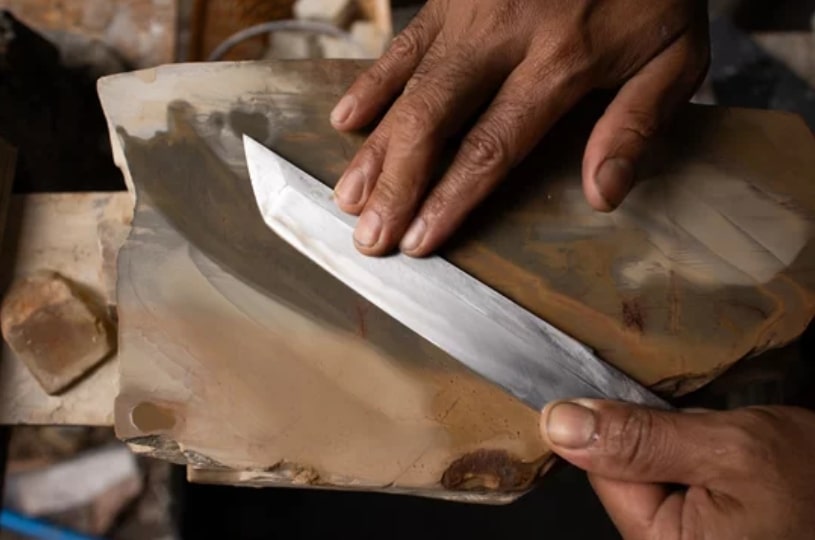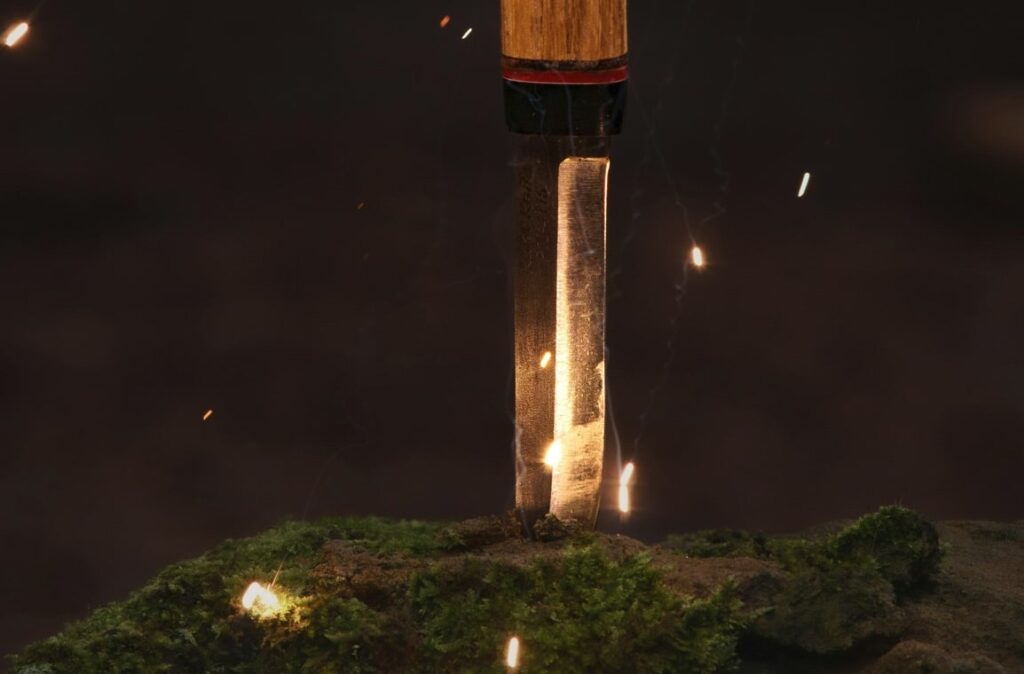Tanto blade knives are distinctive in their design. Featuring an angular edge that is immediately recognizable among different knife styles. Originating from the traditional Japanese short sword with the same design called ‘短刀’. These blades have a rich history that blends the craftsmanship of ancient sword-making with modern tactical needs.
The tanto blade you saw now are most likey of American adaptation with a more flat tip. The American tanto, popularized in the late 20th century, focuses on utility. They often have a more pronounced edge with a secondary point that resembles a chisel tip. In contrary, the Japanese original tends to have a more subtle angle. Harking back to its samurai origins and embodying both a weapon and a work of art.
Tanto knives have their uses and audiences within the knife community, mostly for their appearance. Some people find the flat edge unnecessary and downright bad for certain tasks. How exactly does the tanto work? And how does it compare to other blade shapes? Find out in the following article.
History of tanto blade knives
Tanto blades hold a significant place in Japanese history and have evolved from practical tools to modern tactical implements. This evolution reflects changes in usage, aesthetics, and technology over centuries.
Origins in feudal Japan
The tanto is a traditional Japanese short sword originating in Feudal Japan, with a history stretching back to the Heian Period. Originally crafted for samurai warriors, the tanto was a stabbing weapon designed for accuracy and efficiency in close-quarters combat. Its relatively small size—usually not longer than 30 cm—made it an ideal complement to the longer katana in a samurai’s weaponry.
Evolution to modern designs
Over time, the tanto knife has seen significant adaptations. Cold Steel developed a variation of the tanto blade that was now recognized as American or Western tanto. American tantos favor a more angular approach with a reinforced tip. Which contrasts the more sweeping design of the traditional tanto. This design is often seen in tactical and utility knives today, indicating a shift from the primary function as a weapon to a multifaceted tool.
Design and features

The design of the tanto blade sets it apart from others, such as the spear point or drop point, with its distinctive hill-like, slanted flat tip that catches the eye at first glance. This unique shape and precise blade geometry are not only integral to the functionality of tanto blade knives but also contribute significantly to their aesthetic appeal.
Tanto blade shape
The tanto blade shape is characterized by a high point with a flat grind leading to a strong and sharp secondary point. Unlike most knives that have a continuous edge, tanto-shaped knives often feature a noncontinuous edge, which consists of two sharpened edges meeting at an angle rather than a smooth curve.
Blade geometry and grind
The blade geometry of a tanto blade involves a couple of specific types of grinds. One common grind type found in tanto blades is the hollow grind, which creates a concave, beveled edge designed for sharpness and ease of sharpening. Alternatively, some tanto blades may feature a flat or convex grind for added durability.
Start Working with a Professional Now
Tanto blade uses
When you choose a tanto blade knife, you’re selecting a tool that excels in specific tasks due to its unique design. This section dives into the capabilities and performance of tanto knives for various applications.
Piercing and puncturing
The tanto knife is known for its exceptional piercing and puncturing abilities. This is attributed to its broad and durable point, which provides a robust tip that can penetrate tough materials with ease. While pocket knives often have more conventional shapes designed for general use, the tanto’s piercing capability is especially useful for tactical situations where a reliable stabbing action is paramount.
Cutting and slashing
Your tanto knife might not be the first choice for long slicing tasks due to the angular edge, but it performs remarkably well in cutting and slashing. The pointed angle near the tip, known as the secondary tip, is optimized for slash cuts and allows for effective draw cuts. The cutting and slashing efficiency of a tanto blade is often compared to that of pocket knives, with the main difference appearing in the design intended for slicing versus piercing.
What kind of knives utilize tanto blade

The tanto blade is a design commonly associated with knives that are tailored for piercing and penetrating tasks due to its reinforced tip. Here, we’ll explore the types of knives that predominantly feature the tanto blade.
- Everyday carry knives: EDC knives are among the most frequent users of the tanto blade design. They benefit from a tanto blade when the task requires a strong point for piercing through tough materials, such as plastic packaging.
- Tactical or combat knives: Tanto blades have a historical martial background and thus are well-suited for tactical applications. If you’re in military or law enforcement, you will often find tanto blade knives are designed for the rigors of tactical use because of their durability and robust edge geometry.
- Collectible and traditional knives: Due to their aesthetic appeal and historical significance, many collectors favor tanto-style knives, particularly those reminiscent of traditional Japanese short swords.
- Chef knives: Tanto blades have prevalent uses within the culinary world. Kiritsuke, a type of all-purpose kitchen knife originating from Japan, is extremely popular among professional chefs.
When choosing a knife, especially for retail purposes, keep in mind that the tanto blade shape is distinct for its angular approach and secondary edge. This design translates into robustness but also requires specific sharpening techniques due to the presence of multiple angles. Whether for practical use or as part of a collection, tanto blades provide unique advantages that are tailored to specific cutting and piercing needs.
Tanto blade vs. other blade shapes
When you choose a knife, the blade shape drastically affects its cutting performance and suitability for various tasks. Here’s how a tanto blade compares to other popular types.

Tanto vs. drop point
Drop point blades are known for their strong, controlled slicing ability, courtesy of their curved belly. The drop point design allows for easy skinning or carving, and its tip is less prone to accidental piercing due to its downward curve. In contrast, tanto blade knives are designed with a high point and a flat grind, leading to an incredibly strong point that is perfect for piercing tough materials. However, they lack the drop point’s versatile slicing capability.
Tanto vs. clip point
With a clip point, you get a thinner, sharper, and more defined point due to the concave back, which makes it excellent for detailed work. However, this also makes the tip more fragile in comparison to the robust tip of a tanto blade. Tanto blades offer advantages for piercing through hard materials, but for tasks requiring delicate or precise cutting, a clip point could serve you better.
Tanto vs. spear point
Spear point blades are symmetrical with a point centered along the blade’s long axis, which provides exceptional balance. The design of a spear point is ideal for stabbing or thrusting as it pierces with minimal resistance. Tanto blades have a secondary edge that creates a reinforced tip, providing a different kind of piercing power that’s more about strength and penetration when compared to the more balanced and agile spear point.
Tanto vs. reverse tanto
Reverse tanto blades offer a unique profile that combines the angled approach of a tanto with a more utilitarian belly, resembling a drop point to some extent. This allows for effective slicing while retaining the tanto’s piercing ability. With a traditional tanto, you sacrifice some slicing versatility present in a reverse tanto, but gain a tough, strong point designed for demanding piercing tasks.
Start Working with a Professional Now
Having tanto blade knives in your arsenal
Tanto knives are gaining popularity not necessarily because of their utility, but because of the cool appearance of the blade. Collectors adore the design of the blade. Many popular knife brands, such as Benchmade, Kershaw, and CRKT, have been consistently producing tanto blade knives, receiving great feedback.
Tanto blade knives have been in high demand among Kegani customers. We’ve assisted numerous clients in manufacturing tanto blade knives. Kegani is capable of offering insights and producing high-quality tanto blade knives for you, as well as blades in any other shape. Contact us now to schedule a meeting!

